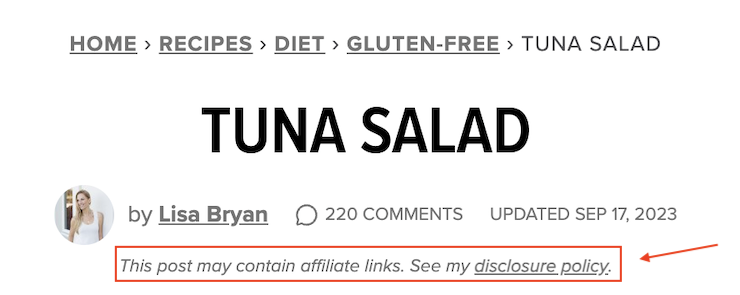If you receive compensation for promoting another company on your site, you need an affiliate disclosure meeting the Federal Trade Commission (FTC) guidelines.
The FTC requires affiliate disclosures to help protect consumers from deceptive marketing practices, and they apply to anyone promoting products or brands.
Below, I explain what an FTC affiliate disclosure is, teach you how to write one, and show what you can learn from looking at examples online.
How To Make An FTC Affiliate Disclosure
You can make an FTC-compliant affiliate disclosure using a disclaimer generator, a template, or writing one yourself.
Generate a Free Customized Disclaimer Using Termly
Here’s how to use Termly’s generator to create a custom and legally compliant disclaimer with an affiliates section.
Step 1: Go to Termly’s disclaimer generator.
Step 2: Answer a few simple prompts and questions, and go through all of the steps until you reach “Final Details.”

Step 3: Once you’ve filled in everything and you are satisfied with the preview, click “Publish.”
You will then be prompted to create an account on Termly so you can save and edit your legal disclaimer further.
What Is an FTC Affiliate Disclosure?
An FTC affiliate disclosure is a statement explaining your relationship to companies that pay you to sponsor or otherwise promote their offerings, following the FTC endorsement guidelines.
Sponsoring a third-party product is known as affiliate marketing — like when internet influencers, bloggers, or YouTubers promote a brand or product they don’t own.
The FTC monitors and creates guidelines for affiliate marketing to ensure it’s not executed unfairly or deceptively.
The FTC broadly defines endorsement of a product in the following way:
… any advertising, marketing, or promotional message for a product that consumers are likely to believe reflects the opinions, beliefs, findings, or experiences of a party other than the sponsoring advertiser, even if the views expressed by that party are identical to those of the sponsoring advertiser. Verbal statements, tags in social media posts, demonstrations, depictions of the name, signature, likeness or other identifying personal characteristics of an individual, and the name or seal of an organization can be endorsements. The party whose opinions, beliefs, findings, or experience the message appears to reflect will be called the “endorser” and could be or appear to be an individual, group, or institution.
In other words, even driving traffic to a company’s website with the expectation of receiving a reward when a product is purchased is considered a promotion.
Your FTC affiliate disclosure must meet the following guidelines:
- The endorsement must reflect honest opinions, beliefs, or findings.
- The advertisement doesn’t need to use the endorser’s exact phrasing unless the ad claims to be doing so.
- The endorser must be a bonafide user of the product.
- Advertisers are liable for misleading or unsubstantiated statements made through endorsements and for failing to disclose an unexpected material relationship between them and the endorser.
- Endorsers can be held liable for the statements they make in an endorsement.
- Advertising agencies, public relations firms, review brokers, reputation management companies, and other similar intermediaries can be held liable for using an endorsement they know is deceptive.
- Using an endorsement with the image or likeness of a person other than the actual endorser is considered deceptive if it misrepresents a material attribute of the endorser.
The disclosure guidelines also apply to the use of user testimonials.
Failing to comply with the FTC affiliate guidelines violates Section 5 of the FTC Act, which prohibits deceptive advertising.
Do I Need An FTC Affiliate Disclosure On My Website?
Anyone engaged in affiliate marketing needs an FTC affiliate disclosure.
Examples of affiliate marketing include product reviews, paid guest posts, or recipe videos that link to a cooking product you use in the recipe.
You may receive different forms of compensation, such as:
- Cash payments (typically paid per click, lead, or sale)
- Special access to products, services, or events
- Free products
- Store credit
- Discounts
If you’re compensated in any of these ways for mentioning a brand or product, I recommend that you include an FTC affiliate disclosure near the relevant link or review to avoid FTC fines.
How to Present an FTC Affiliate Disclosure
When presenting an FTC disclosure on your website, it must be clear and conspicuous.
In other words, users who read it must understand that you’re in a material relationship with a third party and may receive compensation when they click on a link and make a purchase.
The disclosure must also be easy to find and not hidden behind any ‘Read more’ buttons or formatted in a way that blends in with the web page’s background.
If you inconspicuously include an affiliate disclosure in your content in an attempt to draw the least amount of attention, you’re likely not considered compliant with FTC guidelines and I suggest you alter your content.
However, the specific way you present your FTC affiliate disclosure varies based on where and how you include promotions; for example:
Sometimes, hashtags qualify as legitimate disclosures as long as they’re simple (i.e., #ad), which makes it easy to squeeze an FTC affiliate disclosure into a post.
FTC Affiliate Disclosure Guidelines
The FTC affiliate disclosure guidelines were last updated in 2023 and are very clear, so keep these points in mind when posting an FTC affiliate disclosure.
Links in Site Navigation Are Not Adequate Disclosures
Simply linking to your disclosure in the header, footer, sidebar, or other site navigation is not enough to satisfy FTC disclosure guidelines.
The Disclosure Must Appear Before Affiliate Links
Your FTC disclosure must appear before the link leading to the brand’s website or product listing. The FTC advises that the disclosure should appear as close to the beginning of the content as possible or where the audience is likely to first look within the content.
A disclosure at the bottom of a page or article will not likely be considered compliant.
Disclosures Must Be Clear and Conspicuous
If you make any attempt to conceal the nature of your relationship with a brand, your FTC disclosure isn’t compliant. Using tiny fonts, colors that blend in with the page’s background, or any other trick to conceal that compensation is being received does not satisfy FTC guidelines.
Notations Like (Affiliate) or #Affiliate Do Not Meet FTC Guidelines
If users don’t know anything about affiliate marketing, they won’t know what’s being conveyed. But hashtags like #ad meet requirements because an ad is a widely familiar concept.
Disclosures Must Clearly Convey the Relationship Without an Additional Click
Users must clearly understand what’s being disclosed and why without needing to investigate independently. If they have to follow a link like “Click here to read my affiliate disclosure,” that doesn’t satisfy the FTC guidelines.
However, it’s acceptable to say, “This post contains affiliate links for which I may receive compensation. Please click here to read my full FTC Affiliate Disclosure policy.”
FTC Disclosure Examples
The following are examples of adequate FTC disclosures that satisfy guidelines:
FTC Affiliate Disclosure for Bloggers
To start, let’s look at the screenshot below, which shows an example of an FTC blog disclosure found on a Downshiftology tuna salad recipe.

They use a very common form of affiliate disclosure that you’ll see at the top of many similar posts clearly stating that the page contains affiliate links alongside a link to the full disclosure policy.
In compliance with the FTC guidelines, it appears just below the author’s byline, before the post’s content, and is likely to be one of the first things a reader sees.
FTC Affiliate Disclosure for Reviews
Next, let’s look at a sample as a PCMag review disclosure that covers everything it needs to disclose at the very top of the article.
As shown below, their disclosure indicates that the editors review products independently, but if readers purchase through affiliate links, the website may receive commissions.

They include the line: “which helps support our testing,” giving readers the reason affiliate links are included in the review.
Stating that “editors select and review products independently” lets readers know that although PCMag may be compensated, the reviews are valid and unbiased by monetary commission.
FTC Affiliate YouTube Disclosure
According to the FTC guidelines, YouTube affiliate disclosures are considered clear and conspicuous so long as you make a verbal disclosure, include a statement in the video description, and post a statement physically on screen.
Below is a screenshot of an example disclosure from a book review video by the YouTuber Noelle Gallagher.

The creator discloses her referral link verbally in the video and includes the appropriate link in the video description above the ‘… more’ button.
Whether on an article, social media post, or video, your affiliate disclosure must be incorporated into the main body of content:
- For video ads, the disclosure should appear on the screen long enough to be noticed, read, and understood.
- Audio disclosures should be read in a cadence that’s easy for consumers to follow and in words consumers will understand.
Where To Put Your FTC Affiliate Disclosure
According to the FTC affiliate disclosure guidelines, you must put your disclosure in prominent locations so users can easily see, read, and understand it.
For social media posts and video content:
- Place the disclosure in the post’s description above any ‘Read more…’ buttons.
- If it’s a video, verbally state the disclosure.
- Include a visual representation of the disclosure and brand on the screen.
For blogs and websites:
- Post your disclosure at the top of the page.
- Add links or other disclosures near referral or sponsored links in the content.
- Add a link to your complete disclosure statement in the footer of your website.
Summary
With good intentions and a little care, you aren’t likely to get fined by the FTC for affiliate deals and sponsorships.
The FTC seeks to make businesses transparent about their practices to consumers, preventing unfair, deceptive behaviors.
To comply with FTC guidelines, disclose your affiliate relationships within the related content and detail them in your disclaimer page.
To create a disclaimer quickly that meets FTC guidelines, use our free disclaimer generator or customize a disclaimer template.












